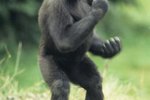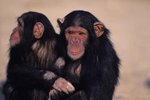
The proboscis, or long-nosed, monkey (Nasalis larvatus) is a large tree-dwelling primate native to Southeast Asia. Known for their large distinctive-looking noses, proboscis monkeys are among the most easily-identifiable of Borneo's primate species. Habitat loss and hunting have led to a decline in the population of proboscis monkeys, and they are considered to be endangered.
Physical Appearance
Proboscis monkeys are named after the bulbous and fleshy nose sported by the male of the species, which makes them easily identifiable. Though females have large noses compared to many other species of monkeys, males' noses are enlarged further and can sometimes exceed nearly 4 inches in length. This impressive schnoz allows males to increase the power of their vocalizations, providing extra resonance.
Proboscis monkeys have other distinguishing features outside of their noses. These medium to large primates can range in color from bright orange to yellow or pink. Baby proboscis monkeys are born with blue faces, which gradually shift to the cream color of adults.
Geography and Range
In the wild, proboscis monkeys are found only on the Southeast Asian island of Borneo, which is divided between the three nations of Indonesia, Malaysia and Brunei. They prefer coastal habitats dominated by mangroves and swamp forests, but can also be found inland in low-lying areas along rivers, in riparian forests and rainforests. Proboscis monkeys rarely move far from the waterways associated with their home range.
Diet and Behavior
Proboscis monkeys are folivores and frugavores, meaning they subsist on leaves and fruits most heavily. Most of their diet is composed of unripened fruits, young leaves, seeds and flowers, though they will occasionally consume insects and bark to supplement their diet.
Proboscis monkeys are active during the day and live in groups that can range from three to 32 monkeys, either all male or all female with one male. Most proboscis monkey groups spend their days feeding, resting, traveling and watching for predators.
Population and Threats
The population of the proboscis monkey is on the decline and the species has been listed as endangered since 2000. According to the IUCN Red List of Threatened Species, proboscis monkeys are limited to scattered and inconsistently distributed populations throughout their native range. Population estimates suggest that in some areas where populations once numbered in the thousands, few monkeys remain.
The primary threat to proboscis monkeys is habitat loss. The coastal habitats frequented by proboscis monkeys have been converted into shrimp farms and settled by humans. Logging of mangrove stands along riverbanks and frequent forest fires have also contributed to the loss of proboscis monkey habitat. Hunting accounts for some population loss as well, as proboscis monkeys are relatively docile and easily taken for food and for their intestinal bezoar stones, which are used in traditional medicine.
References
Photo Credits
-
Anup Shah/Digital Vision/Getty Images




